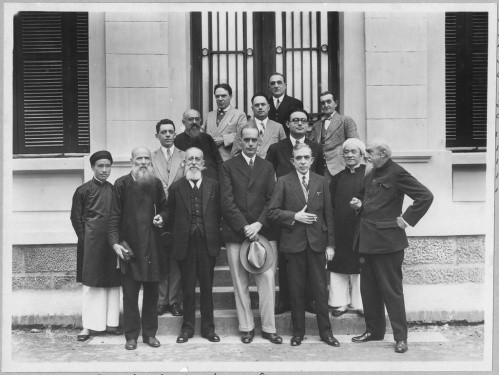
MUS Paul (EN)
Biographical Article
Paul Mus was born into a family of teachers, where his intellectual faculties could flourish from a very young age. He spent his childhood in Indochina and then returned to France to study. In his post-baccalaureate khâgne studies at the Lycée Henri-IV he was taught by the philosopher Alain (1868-1951). He turned to Orientalism and became a student of Sylvain Lévi (1863-1935) in Sanskrit and Tibetan, and of Arnold Vissière (1858-1930) in Chinese. He also studied Thai and Vietnamese. He became a member of the École française d'Extrême-Orient (EFEO) in 1927 and in 1933 defended a remarkable doctoral thesis on Borobudur. In 1937, he was appointed director of studies at the fifth section of the École Pratique des Hautes Etudes. He served as an officer during World War II. At the end of 1940, he reached Calcutta and La France libre for whom he parachuted into Tonkin in 1944. During the Japanese coup of March 9, 1945, he was in Hanoi and worked for the special services. He escaped the Japanese, reaching Son La on foot and then went on to Kunming, which afforded him many adventures. After the Japanese capitulation, he became General Leclerc's adviser for some time and intervened in favour of a policy that clearly granted independence to Vietnam. Following failure, he withdrew. Back in France, he was then appointed director of the École nationale de la France d’outre-mer (the National School of Overseas France). In 1946, he obtained the chair of Civilisations of the Far East at the Collège de France. A few years later, he agreed to assume parallel teaching at Yale University. In his work, Paul Mus favoured in-depth understanding over diversity. He sensed the distance between "the man in the field" and the scholar in the office, and insisted that one must “not take a library for the equivalent of a country". He applied himself to researching the ancient substrates, "the antecedents, warped and concealed by the Brahmanic contributions to India (or Confucian to China).” For this, he combined the results of several disciplines: linguistics, ethnography, archeology, and the history of religions. An excellent formulation of this appears in his 1934 lecture "Indian and Native Cults in the Campa” (Cultes indiens et indigènes au Campa). For the archaeologist of the Borobudur, this monument and the stûpa in general were among the great sources of reflection and the best frame of reference for his research on the history of Buddhism.

Related articles
Personne / personne

Collection / collection d'une personne

